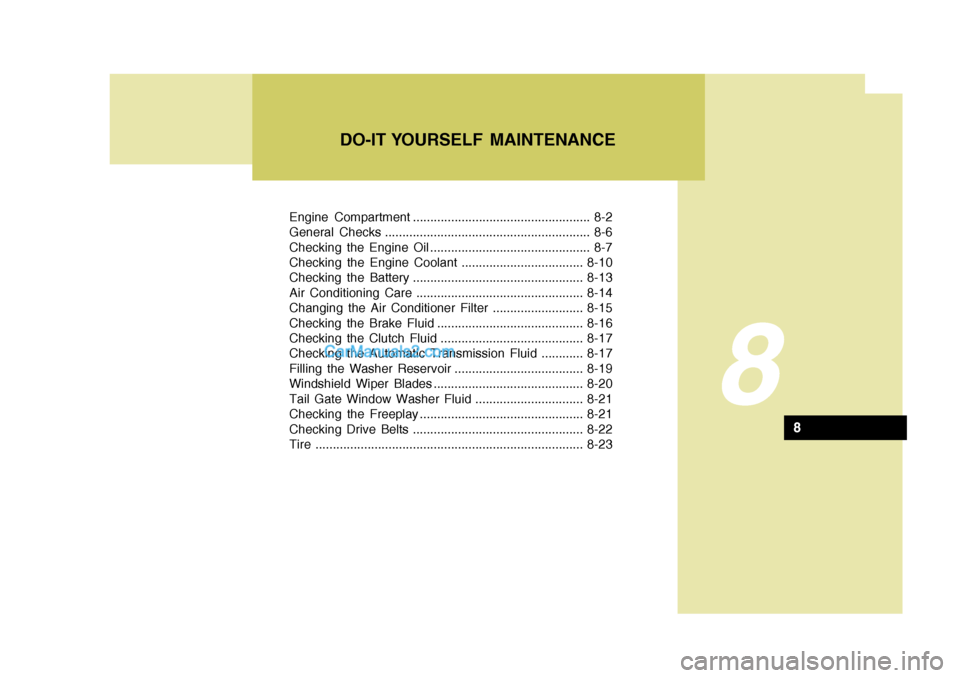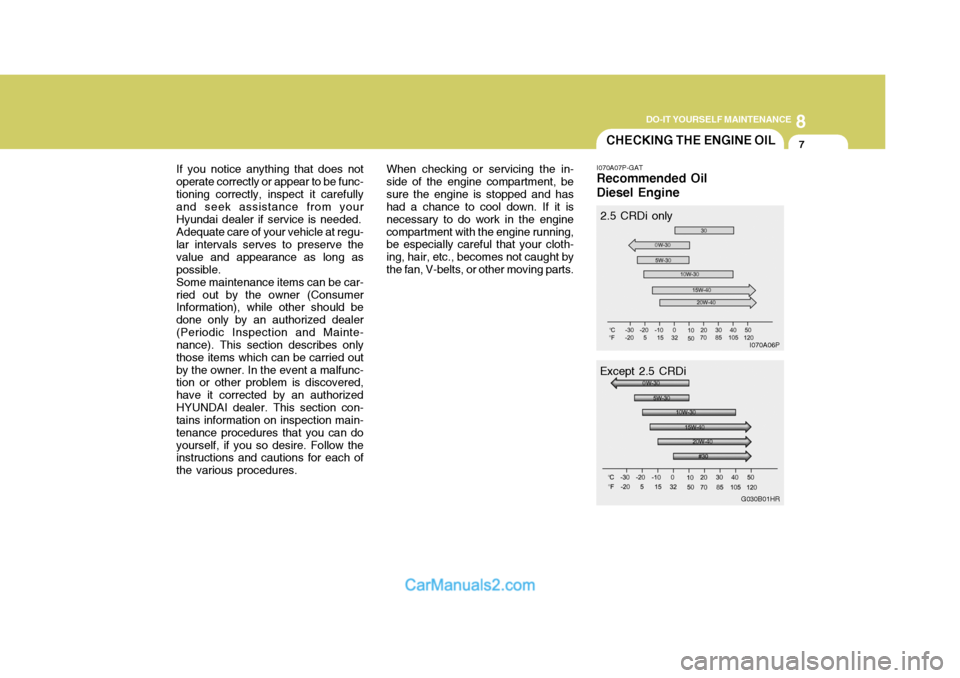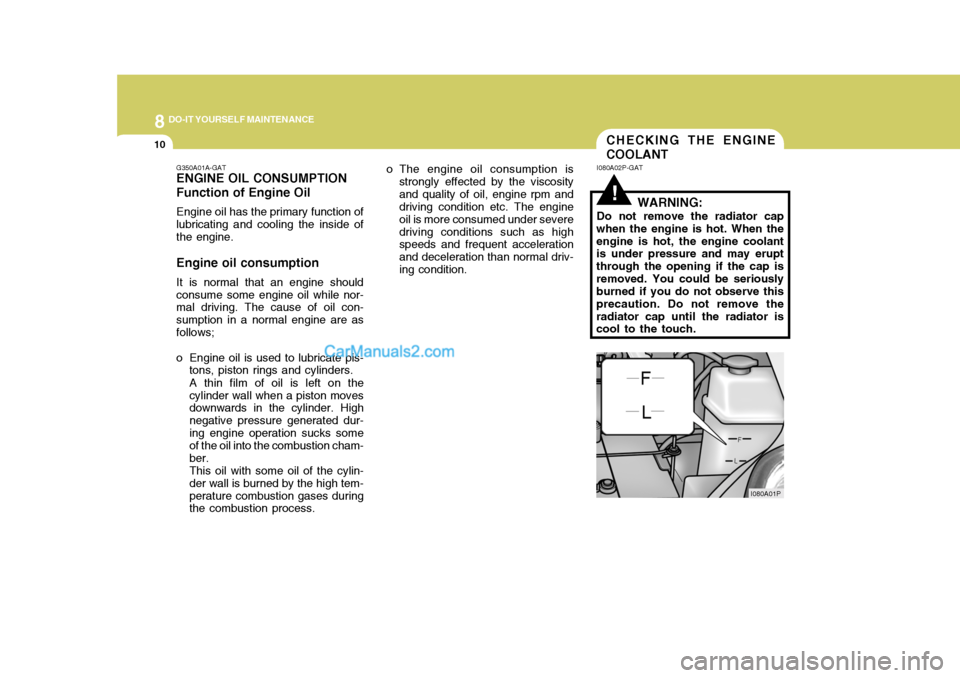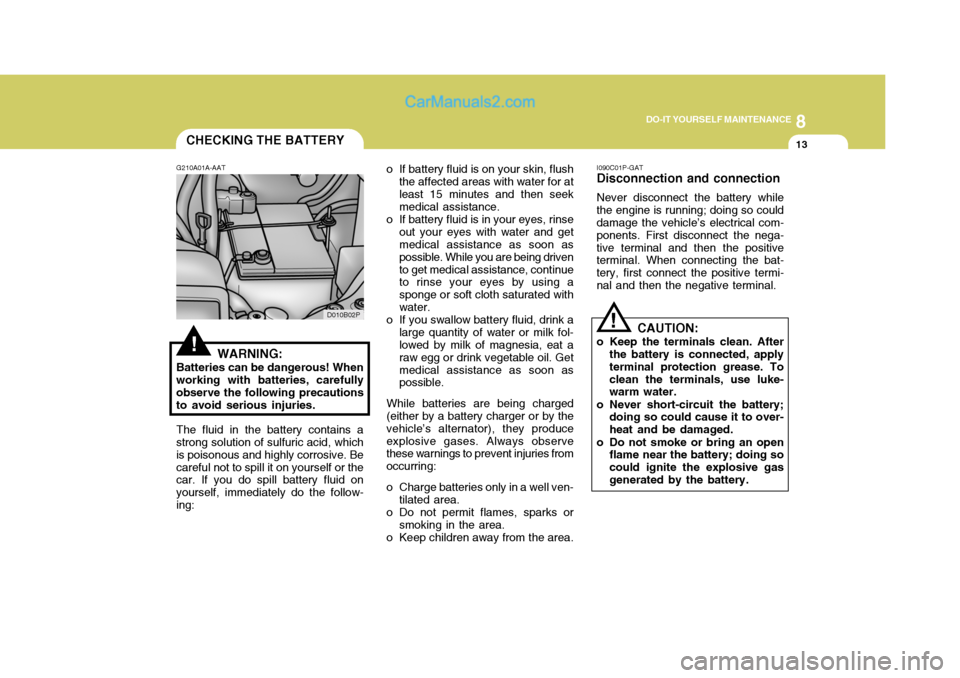Page 170 of 205

Engine Compartment ................................................... 8-2
General Checks ........................................................... 8-6
Checking the Engine Oil .............................................. 8-7
Checking the Engine Coolant ...................................8-10
Checking the Battery ................................................. 8-13
Air Conditioning Care ................................................ 8-14
Changing the Air Conditioner Filter .......................... 8-15
Checking the Brake Fluid .......................................... 8-16
Checking the Clutch Fluid ......................................... 8-17
Checking the Automatic Transmission Fluid ............ 8-17
Filling the Washer Reservoir ..................................... 8-19
Windshield Wiper Blades ........................................... 8-20
Tail Gate Window Washer Fluid ............................... 8-21
Checking the Freeplay ............................................... 8-21
Checking Drive Belts ................................................. 8-22
Tire ............................................................................. 8-23
8
DO-IT YOURSELF MAINTENANCE
8
Page 176 of 205

8
DO-IT YOURSELF MAINTENANCE
7CHECKING THE ENGINE OIL
If you notice anything that does not
operate correctly or appear to be func- tioning correctly, inspect it carefully and seek assistance from your Hyundai dealer if service is needed.
Adequate care of your vehicle at regu-
lar intervals serves to preserve thevalue and appearance as long aspossible.
Some maintenance items can be car-
ried out by the owner (Consumer Information), while other should be done only by an authorized dealer(Periodic Inspection and Mainte- nance). This section describes only those items which can be carried outby the owner. In the event a malfunc- tion or other problem is discovered, have it corrected by an authorizedHYUNDAI dealer. This section con- tains information on inspection main- tenance procedures that you can doyourself, if you so desire. Follow the instructions and cautions for each of the various procedures. When checking or servicing the in-side of the engine compartment, besure the engine is stopped and has had a chance to cool down. If it is necessary to do work in the enginecompartment with the engine running, be especially careful that your cloth- ing, hair, etc., becomes not caught bythe fan, V-belts, or other moving parts.
I070A07P-GAT Recommended Oil Diesel Engine
2.5 CRDi only
I070A06P
Except 2.5 CRDiG030B01HR
Page 179 of 205

8DO-IT YOURSELF MAINTENANCE
10CHECKING THE ENGINE COOLANT
G350A01A-GAT ENGINE OIL CONSUMPTION Function of Engine Oil Engine oil has the primary function of lubricating and cooling the inside of the engine. Engine oil consumption It is normal that an engine should consume some engine oil while nor- mal driving. The cause of oil con- sumption in a normal engine are asfollows;
o Engine oil is used to lubricate pis-
tons, piston rings and cylinders. A thin film of oil is left on the cylinder wall when a piston moves downwards in the cylinder. High negative pressure generated dur-ing engine operation sucks some of the oil into the combustion cham- ber.This oil with some oil of the cylin-der wall is burned by the high tem-perature combustion gases during the combustion process. o The engine oil consumption is
strongly effected by the viscosity and quality of oil, engine rpm and driving condition etc. The engine oil is more consumed under severedriving conditions such as high speeds and frequent acceleration and deceleration than normal driv-ing condition. I080A02P-GAT
!WARNING:
Do not remove the radiator cap
when the engine is hot. When the engine is hot, the engine coolant is under pressure and may erupt through the opening if the cap isremoved. You could be seriously burned if you do not observe this precaution. Do not remove theradiator cap until the radiator is cool to the touch.
I080A01P
Page 182 of 205

8
DO-IT YOURSELF MAINTENANCE
13
D010B02P
CHECKING THE BATTERY
!
G210A01A-AAT
WARNING:
Batteries can be dangerous! When working with batteries, carefully observe the following precautionsto avoid serious injuries. The fluid in the battery contains a
strong solution of sulfuric acid, which is poisonous and highly corrosive. Becareful not to spill it on yourself or the car. If you do spill battery fluid on yourself, immediately do the follow-ing: o If battery fluid is on your skin, flush
the affected areas with water for atleast 15 minutes and then seek medical assistance.
o If battery fluid is in your eyes, rinse out your eyes with water and getmedical assistance as soon as possible. While you are being drivento get medical assistance, continue to rinse your eyes by using a sponge or soft cloth saturated withwater.
o If you swallow battery fluid, drink a large quantity of water or milk fol- lowed by milk of magnesia, eat a raw egg or drink vegetable oil. Getmedical assistance as soon as possible.
While batteries are being charged(either by a battery charger or by the vehicle’s alternator), they produceexplosive gases. Always observe these warnings to prevent injuries from occurring:
o Charge batteries only in a well ven- tilated area.
o Do not permit flames, sparks or smoking in the area.
o Keep children away from the area. I090C01P-GAT Disconnection and connection Never disconnect the battery while the engine is running; doing so could damage the vehicle’s electrical com- ponents. First disconnect the nega-tive terminal and then the positive terminal. When connecting the bat- tery, first connect the positive termi-nal and then the negative terminal.
CAUTION:
o Keep the terminals clean. After the battery is connected, applyterminal protection grease. Toclean the terminals, use luke- warm water.
o Never short-circuit the battery; doing so could cause it to over- heat and be damaged.
o Do not smoke or bring an open flame near the battery; doing socould ignite the explosive gasgenerated by the battery.
!